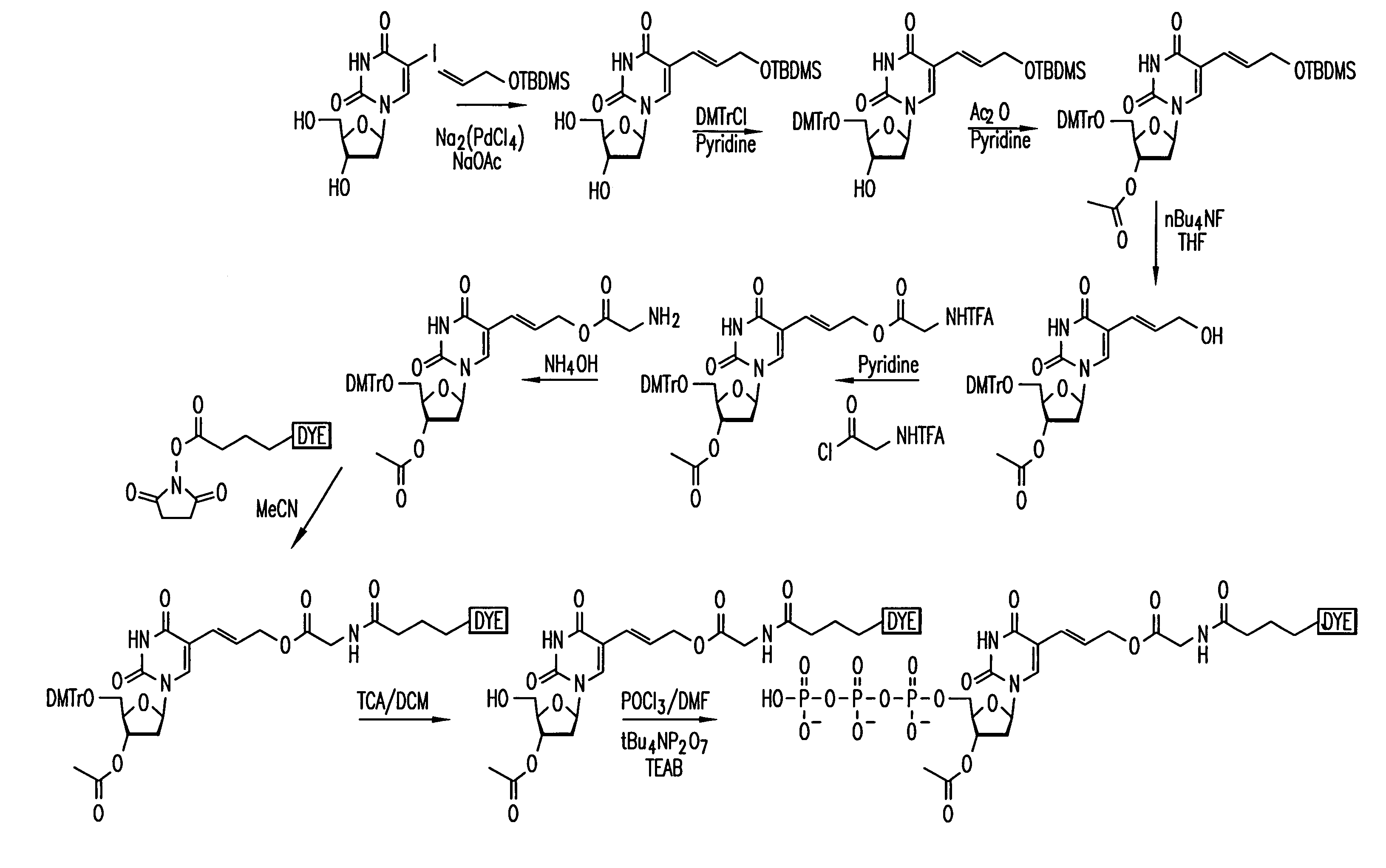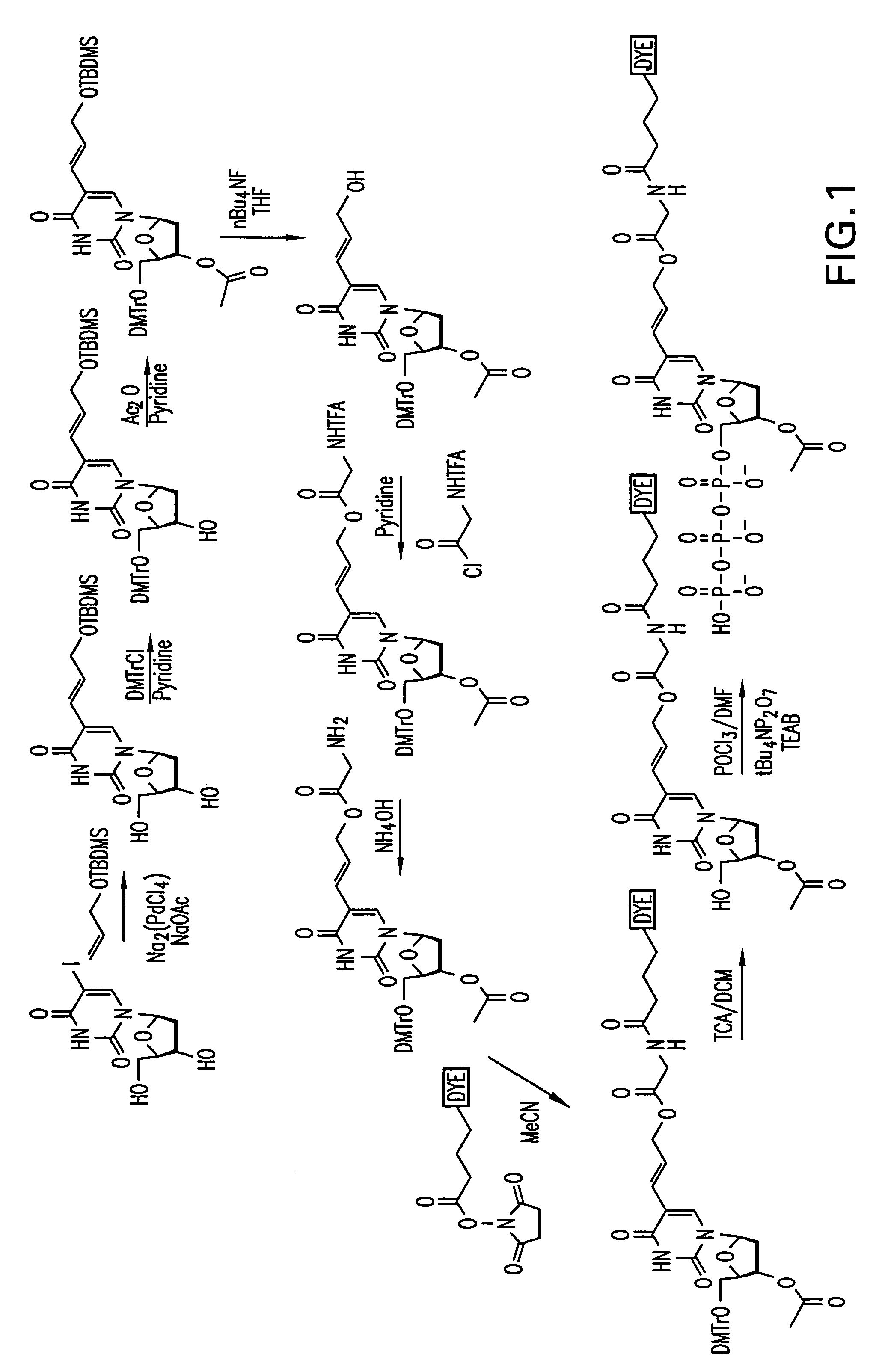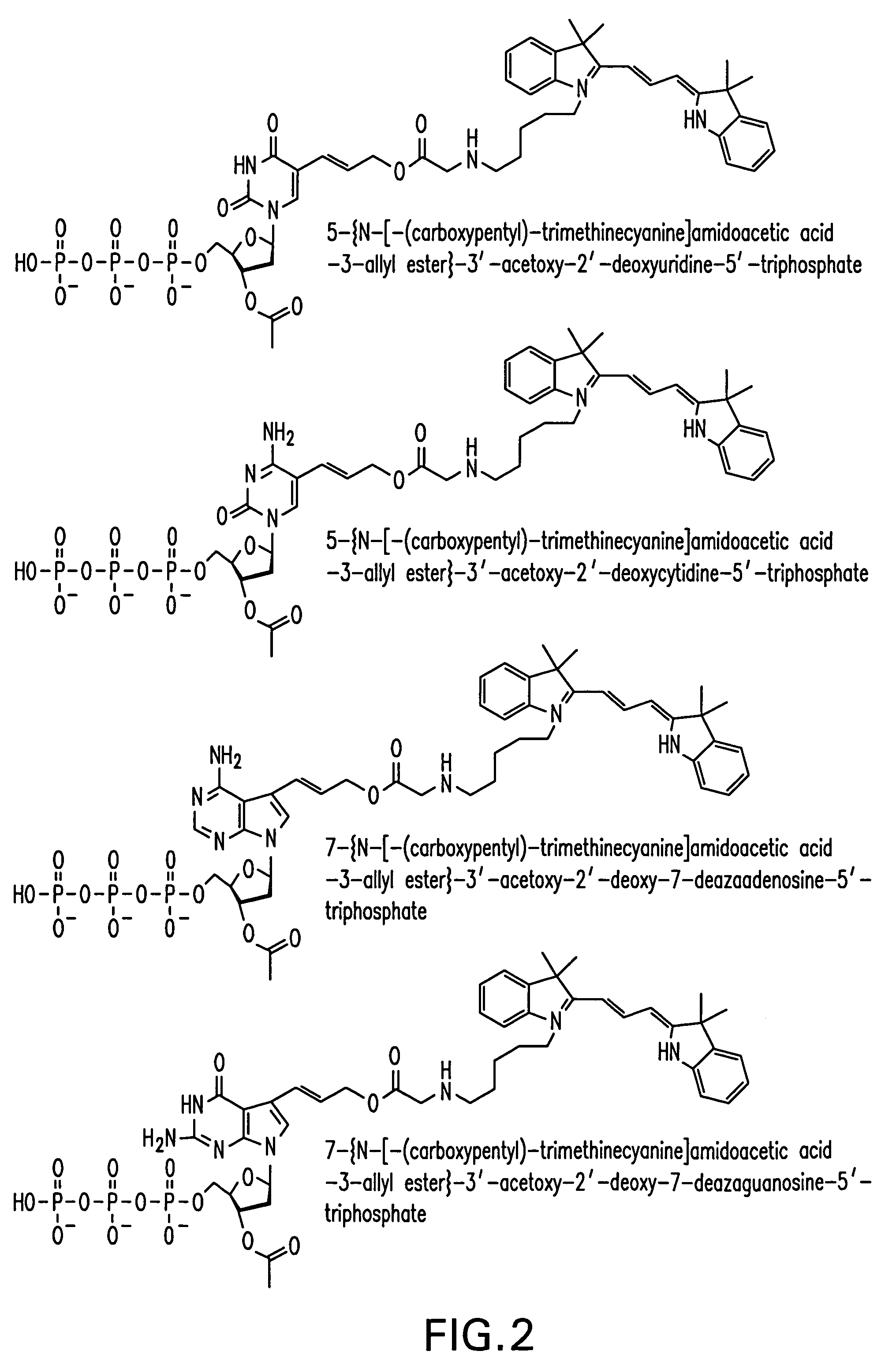Nucleotide analogues comprising a reporter moiety and a polymerase enzyme blocking moiety
a reporter moiety and polymerase enzyme technology, applied in the field of nucleoside and nucleotide analogues, can solve the problems of reducing the ability of dna polymerase to recognise or tolerate the nucleotide, reducing the efficiency of dna polymerase, and reactivity of certain chemical bonds
- Summary
- Abstract
- Description
- Claims
- Application Information
AI Technical Summary
Benefits of technology
Problems solved by technology
Method used
Image
Examples
example 1
[0086]A reaction scheme for the synthesis of an example of a compound of Formula I is set out in FIG. 1 using 5-iodo-2′-deoxyuridine (Sigma-Aldrich Chemical Co.) as the starting material and incorporating the dye, Cy3, by reaction with (N-hydroxy)succinimide Cy3 ester.
[0087]In the reaction scheme, the following abbreviations are used: TBDMS—tertbutyldimethylsilyl; DMTr—Dimethoxytrityl; TFA—trifluoroacyl; nBu—linear Butyl chain; MeCN—Acetonitrile; TCA—Trichloroacetic acid; DCM—Dichloromethane; DMF—N,N-Dimethylformamide; TEAB—Tetraethylammonium bicarbonate buffer, THF—Tetrahydrofuran; Ac—Acetyl.
[0088]Wherein TBDMS, Ac, TFA and nBu have the following structural formulae:
[0089]
example 2
Synthesis of Nucleotides with a 4′ Groups (4′-C(Glycylaminomethyl)thymidine triphosphate (6), 4′-C-(N-trifluoroacetylaminomethyl)thymidine triphosphate (8) and 4′-C-(Aminomethyl)thymidine triphosphate (9)).
[0090]FIG. 3 illustrates the synthetic pathway for nucleotide analogues indicated as (6), (8) and (9) via the intermediate compound (4).
i) 3′-O-[(tertbutyl)dimethylsilyl]-5′-O-[(tertbutyl)diphenylsilyl]-4′-C-(1,1′-diphenylmethylaminomethyl)thymidine (2).
[0091]The starting material 3′-O-[(tertbutyl)dimethylsilyl]-5′-O-[(tertbutyl)diphenylsilyl]-4′-C-formylthymidine (1) (described in Marx et al. Helv. Chim. Acta. 1996, 79, 1980–1994 and references cited therein.) (1.7 g, 2.7 mmol) and Ph2CHNH2 (0.53 g, 2.9 mmol; 0.5 mL) were dissolved in anhydrous acetonitrile (10 mL) at ambient temperature. Neat glacial acetic acid (0.11 g, 1.9 mmol, 0.11 mL) was then added and the solution stirred for 30 minutes at ambient temperature, during which time a white precipitate formed. Solid NaBH3CN (0...
example 3
Synthesis of Nucleotide with a 4′ Blocking Group and a Fluorescent Label Attached to the Base (5-[N-Fluorescein-5(and-6)carboxamidohexanoyl]propargylamino4′-C-(acetylaminomethyl)-2′-deoxyuridine triphosphate (18)).
[0099]FIG. 4 illustrates the synthetic pathway for the nucleoside analogue, 5-(N-Trifluoroacetyl)propargylamino-4′-C-(acetylaminomethyl)-2′-deoxyuridine (16).
i) 3′-O-[(tertbutyl)dimethylsilyl]-5′-O-[(tertbutyl)diphenylsilyl]-4′-(1,1′-diphenylmethylaminomethyl)-2′-deoxyuridine (11).
[0100]3′-O-[(tertbutyl)dimethylsilyl]-5′-O-[(tertbutyl)diphenylsilyl]-4′-C-formyl-2-deoxyuridine (10) (Yang et al; Tetrahedron Letters 1992, 33, 37–40.) (0.15 g, 0.25 mmol) was treated with Ph2CHNH2 (0.07 g, 0.37 mmol, 0.064 mL), glacial acetic acid (0.015 g, 0.26 mmol, 0.015 mL) and NaBH3CN (0.023 g, 0.37 mmol) in acetonitrile (1 mL) according to the procedure used for the preparation of compound (2). The title compound (11) was obtained as clear, viscous oil (0.13 g, 69%). δH(300 MHz, CDCl3) 8....
PUM
 Login to View More
Login to View More Abstract
Description
Claims
Application Information
 Login to View More
Login to View More - R&D
- Intellectual Property
- Life Sciences
- Materials
- Tech Scout
- Unparalleled Data Quality
- Higher Quality Content
- 60% Fewer Hallucinations
Browse by: Latest US Patents, China's latest patents, Technical Efficacy Thesaurus, Application Domain, Technology Topic, Popular Technical Reports.
© 2025 PatSnap. All rights reserved.Legal|Privacy policy|Modern Slavery Act Transparency Statement|Sitemap|About US| Contact US: help@patsnap.com



